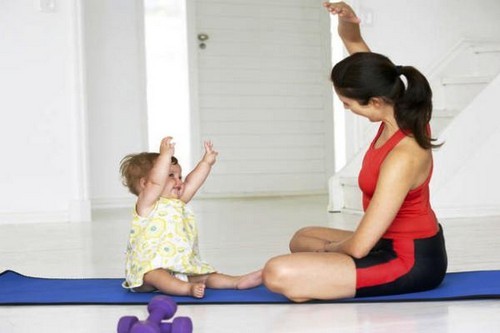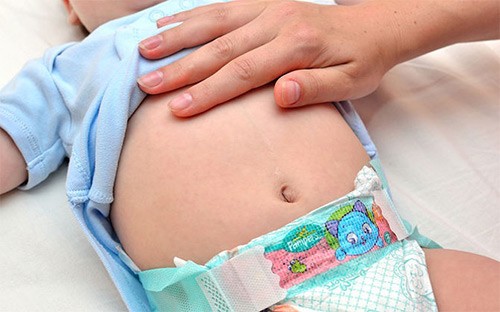Three-year-old children are actively developing both physically, emotionally, and mentally. They have already learned a lot, when compared with skills in a year or two.
Let’s look at what a 3-year-old baby can do, why there is a development crisis at this age and how to cope with it, as well as through what activities to develop a three-year-old child.
Age features
- The motor development of the child is being improved. A kid at the age of 3 controls his own body well. He walks evenly, without unnecessary movements, can change the pace of walking and is able to learn to ride a bicycle.
- The performance of the nervous system of a three-year-old child becomes greater. The child is awake for a longer time and is ready to absorb new information. He is already more patient and can do any one thing longer than in 2 years (up to 20-25 minutes).
- Fine motor skills are also improved, allowing the baby to master button fastening, pencil drawing, the use of cutlery and other household skills.
- The vocabulary of a 3-year-old baby already includes more than 1000 words. The child uses in conversation almost all parts of speech, although sometimes incorrectly. The pronunciation of sounds improves, although children at 3 years old may not yet pronounce many sounds. Three-year-olds constantly pronounce their actions, giving the impression that they are not silent at all. Also a characteristic feature of the speech of children of this age is the presence of numerous questions.
- The main activity of a child of three years remains a game. Now the baby loves role-playing games most of all. In the scenes played out by the child, there is a plot, since the crumbs develop abstract thinking and imagination.
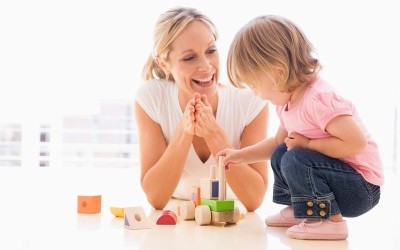
What should a child be able to do?
- Run fast, jump, step over obstacles.
- Pronounce up to 1,500 words and make complex sentences out of them.
- Long listen to fairy tales.
- Ask a lot of questions.
- Perform the task without being distracted for at least 5 minutes.
- Tell a familiar fairy tale from the picture.
- Learn poems and songs.
- Pronounce your first and last name, know your age (shows on your fingers) and gender.
- Show body parts and know their purpose.
- Call yourself “I”.
- Greet, say goodbye and say “thank you.”
- Perform 2 actions simultaneously, for example, clap and stomp.
- Play with other kids by sharing toys.
- Ride a 3-wheeled bicycle, sled, and also on a swing.
- Count to three.
- Orient in 7 colors (including white and black) and in geometric shapes.
- Collect toys from 4-6 parts.
- Understand the difference in the size of objects, their shape and weight.
- Draw as you wish.
- Fantasy in role-playing games and follow the rules in mobile.
- Dress yourself, as well as undress and fold your own clothes.
- Fasten buttons and tie shoelaces.
- Use a handkerchief.
- Gently eat (not only with a spoon, but also with a fork) and use a napkin.
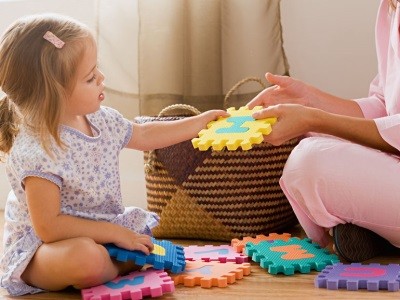
What is a “three-year crisis”?
The behavior of most children at the age of 3 is strikingly changing, causing parents to be misunderstood and panic. Mom begins to worry that she missed something in the upbringing, but in fact these are absolutely normal changes for children of this age.
Child development goes through several crises, among which the three-year-old is the most turbulent and difficult for parents. It gradually grows, starting from 2 years of age. At its peak, such a crisis is manifested by violent tantrums and conflicting behavior of the child, but soon passes, becoming a real school of life for the peanut.
The main features of the “3 years crisis” are:
- Negativism of the child. The kid answers “no” to all offers from adults.
- Stubbornness. The child insists on his own opinion and proposal.
- Refusal of actions that previously did without any problems, for example, the child does not want to eat, wash or brush his teeth.
- The desire to do everything yourself, even if you can’t. The child is in no hurry to seek help.
- Conflict behavior. The child rebels and protests against almost everything that parents say.
- Depreciation. Before, a calm, quiet baby can defiantly throw and break toys, spoil things, and curse.
- Jealousy. It is especially pronounced in the presence of other children in the family, but can also be directed at the father.
The appearance of such changes in the behavior of a baby of three years old is associated with the awareness of the crumbs that he is already quite old to influence circumstances and other people, and is also able to make decisions. The child considers himself great and wants to be respected. He rebels against the command of his parents, so he becomes stubborn, screaming, hysterical. However, conflicting behavior is tolerated by the child no less hard than by his parents. The kid cannot understand what is happening to him, nor can he control his own emotions.
The most powerful manifestation of the three-year crisis is tantrums. At an earlier age, they could occasionally arise due to overwork, and the main action of the parents was to calm the baby. At the age of 3, tantrums become a way of manipulation. That is why they appear in places where there are spectators, for example, on the street or in a store.
- Change your baby communication strategy. Recognize that the child has grown and can show independence. Stop doing something for the baby that he can handle on his own.
- Always offer a choice or its illusion. For example, if you have a walk, ask the baby how you will go down – on the elevator or on the stairs, and if dinner is coming soon, ask which plate the child will eat from red or green.
- Do not force the child to do anything, but offer to help you. For example, you are going to cross the street. Do not tell the child that it is dangerous and you must definitely hold the adult’s hand, but offer to transfer you across the road, as you are afraid of cars.
- Give your child more time for any action so as not to rush.
- If the child puts an ultimatum, answer “no” and try to stay calm. Do not pay attention to screams, falling to the floor, the looks of passers-by. If you go on occasion, this behavior will be repeated more than once.
- Raise a child who has fallen on the roadway or in a puddle, take it to a safe place and leave it to shout there.
- Do not criticize or scold the child after hysteria. Better teach the baby to express their emotions in words.
Height and weight
If we compare with the indicators of 2.5 years, the child adds about 1000-1200 g to his three-year-old and grows by 4-5 cm. The physical development indicators of girls are usually slightly lower than boys. To help you determine if the rate of physical development of your three-year-old child is normal, we have collected in the table the average values of the main parameters, as well as the boundary indicators of the norm for each gender:
| Index | 3 years average | Limits of norm for boys 3 years | Limits of norm for girls 3 years |
| Weight | 13900-14300 g | 11300-18300 g | 10800-18100 g |
| Height | 95.1-96.1 cm | 88.7-103.5 cm | 87.4-102.7 cm |
| Head circumference | 48.5-49.5 cm | 46.6-52.3 cm | 45.7-51.3 cm |
| Chest circumference | 51.8-52.5 cm | 50-55 cm | 49.1-56 cm |
Types of child development
Physical
This type of development is aimed at increasing the endurance of the child, the development of dexterity and coordination of movements.
Classes affecting physical development should be daily for a three-year-old child and may include such activities:
- Charging to music, poetry or a video lesson.
- Step over obstacles (lay the bars on the floor).
- Walking on an inclined board.
- Jumping over a line drawn on the floor.
- Walking on the rope laid on the floor.
- Jumping on two legs from a forward position.
- Jumping from small hills.
- Ball games – throw each other, throw up, and then catch, kick, get into the box, run racing with a rolling ball, roll between the legs of the chair.
- Outdoor games with simple rules.
- Overcoming an obstacle course.
- Dancing.
- Fitness with mom.
- Swimming.
- Exercises on the sports wall (rope, rings, ladder, horizontal bar).
- Bicycle riding.
Cognitive
This type of development helps to study the surrounding world and various properties of objects. Classes with a cognitive purpose will develop attention, logic, and memory in a peanut. In a game form, the baby learns the first mathematical concepts, learns more about the world in which he lives.
Classes at the age of three may be as follows:
- We are looking for colors by name and pattern.
- We consistently collect nesting dolls and molds of different sizes.
- We select flat geometric shapes according to the model.
- We select volumetric geometric shapes to the holes and study their names.
- We assemble a pyramid of 8-10 rings of different colors and sizes, guided by a pattern or sample.
- We study the differences between the concepts of small-medium-large.
- We add a picture of 2 parts.
- We play with mosaic and lotto.
- We remember the place in which the toy was located, which was removed by an adult.
- We are looking for a whole picture by its details.
- We study the concept of right-left.
- We generalize objects according to some property, for example, floating, flying.
- We study the phenomena of nature, flora and fauna, labor activities with the child.
- Find the extra item in the group.
- Choose the opposite from the group of objects.
- We study the numbers.
- We are looking for the shadow of the picture.
- We select patches.
- Add the missing items.
Touch
Such development involves the child’s sense organs – touch, taste, smell, sight, hearing. While practicing sensorics, the baby improves tactile sensitivity, learns to recognize objects by smell and taste. Such activities at the age of three may include:
- Determination of the texture of objects.
- Determination of geometric shapes by touch.
- Guessing animals by the sounds they utter.
- Games with sensory pouches and boxes.
- Guessing objects by smell.
- Guessing food to taste.
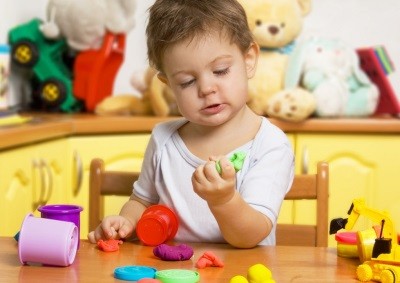
Musical
This type of development of a three-year-old baby not only affects the child’s hearing, but also instills a sense of rhythm and musical taste in him.
You can develop your baby with the help of such classes:
- Singing.
- Playing a musical instrument.
- Listening to music with a different rhythm.
- Guessing the sounds of household items.
- Guessing the songs.
- Dancing.
- Music backround.
Speech
For a child of 3 years old, it is very important to constantly expand the vocabulary, so you should communicate more with the peanut. Articulation classes also affect speech development.
With a baby of this age, speech development can be done like this:
- Learn songs and poems.
- Discuss plot pictures.
- Tell a fairy tale from the pictures.
- Discuss read.
- Listen to a fairy tale that an adult reads, as well as in audio recordings.
- To riddle the baby with a riddle in which the answer is the last word of the quatrain.
- Talk with your baby about how the day went.
- Discuss different situations on the topic of “what if?”
- Perform articulation gymnastics.
- Learn vowels.
Fine motor skills
Developing motor skills is extremely important for stimulating the speech development of the toddler, since the brain areas responsible for speech and arm movement are very close. If during the lessons the baby will use his fingers more, you will simultaneously stimulate the speech zone.
Suitable classes for fine motor skills for a 3-year-old baby are:
- Finger gymnastics.
- Games with sand and cereals.
- Fastening buttons, eyelets, different fasteners, buttons.
- Stringing multi-colored beads on a cord, including alternating colors and shapes of beads.
- Games with nesting dolls, lacing, mosaic, inserts, clothespins.
- Laying out patterns of pasta, shells or pebbles.
- Games with water.
Creative
The classes that will stimulate the creativity of the child include various types of drawing and applications, games with designers, modeling and the like.
With a baby of three years old, you can do this:
- Draw details for drawings, for example, leaves to a branch or stems to flowers.
- Draw lines, rectangles, ovals and circles.
- Paint over the drawing.
- Draw according to your plan and tell what he draws.
- Roll plasticine or dough in the palms and sculpt simple shapes (sausages, balls, bagels).
- Make simple applications using paper, natural materials, pieces of fabric.
- To build bridges, fences, houses from cubes using the speech instruction, your imagination, sample or drawing.
- Cut with baby scissors.
- Decorating cakes or sandwiches with mom.
- Stage a fairy tale.
- Play with a puppet theater.
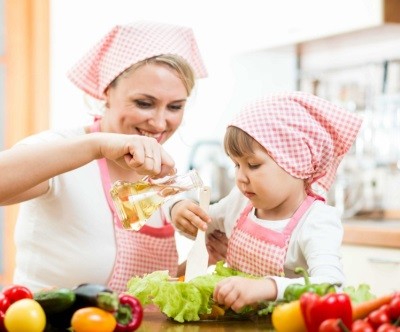
Social
A three-year-old reaches for peers and communicates a lot with other children. Many kids of this age are already attending kindergarten, so their social development is at its own pace while communicating with children in the group. If the three-year-old does not yet go to the garden, it is important for parents to pay additional attention to the social development of the child. In addition, this type of development also includes the acquisition of skills that children will need in everyday life.
Classes aimed at the social development of crumbs will be as follows:
- Games with other children using substitute items.
- Learning the words of courtesy.
- Folding clothes before bedtime.
- Training on tying shoelaces and button fastening.
- Learning the rules of conduct at the table.
- All possible help around the house.
Sample exercise program for the week
Having drawn up a weekly lesson plan for the development of a three-year-old child, you will be able to evenly distribute the classes by the days of the week, while not missing anything, but not overloading the peanut. For each child, such a lesson plan will be his own. Its compilation should be based on the interests of the baby and mother, as well as the presence of certain skills of the peanut. The plan includes attending sports and developmental classes, massage and other mandatory activities.
When drawing up a plan for the first time, it is better to focus on the minimum list of classes. In one or two weeks you will be able to analyze how the child is doing, whether it is necessary to add any classes, what the baby likes best and what is more difficult.
We offer such an approximate weekly schedule of developmental activities for a 3-year-old child:
| Monday | Tuesday | Wednesday | Thursday | Friday | Saturday | Sunday | |
| Physical development | Swimming | Video lesson charging | Ball games | Jumping | Charging to the music | Game with fitball | Outdoor games |
| Cognitive development | Learning numbers | We study birds | Puzzles | Looking for the whole by detail | Lotto | The study of natural phenomena | Learning colors |
| Sensory development | Touch Bag Games | Exploring tastes | We study the smells | Guessing objects by touch | |||
| Fine motor skills | Finger gymnastics | Game with clothespins | Sand play | Game with beads | Mosaic | Play with water | Game with croup |
| Musical development | Dancing | Singing | Learning musical instruments | Music background | |||
| Speech Development | Reading a fairy tale | Articulation gymnastics | We tell a fairy tale from the picture | Learning a verse | Audio tale | Puzzles | We discuss the plot of the picture |
| Creative development | Modeling | Painting | Puppet show | Painting | Designer Games | Coloring | Applique |
| Social development | We study etiquette | Peer Games | Learning the words of courtesy |
Care and mode
In the development of 3-year-old children, attention should be paid to maintaining the health of babies, so the importance of the day regimen and caring for the baby is beyond doubt:
- The kid should have enough rest. The approximate duration of sleep at 3 years of age is 12-13 hours per day. Many children can refuse to sleep in the daytime, but pediatricians say that preschool children need rest during the day, so parents should try to put the child to sleep for 1-2 hours during the day.
- The morning of a three-year-old should begin with hygiene procedures. The child should wash himself, brush his teeth and comb his hair. Parents should constantly remind the baby to wash their hands before eating and after returning from a walk, as well as after using the toilet.
- Many parents continue to temper their children, conduct procedures in the period after a nap. Such procedures include sunbathing, walking in the fresh air, wiping with a damp towel, dousing the feet or the whole body, contrast shower, bathing in ponds.
- With a three-year-old child, it is advised to walk 1-2 times a day, dressing a baby in the weather.
- In the diet of a child of this age, 4 meals are provided, between which 3-4 hours pass. The nutritional value of the daily diet of three-year-olds is 1500-1800 kcal.
Advice
- At the age of three, it is important to ensure that the child has toys that will support the motor activity of the baby (ball, bike, skittles and the like). Also, for games of a three-year-old peanut, designers and pyramids, lotto and cubes, books and posters, sets for creativity and toys for role-playing games (dolls, animals, dishes, products and others) are needed.
- If a child has to start attending a kindergarten, discuss with a tiny bit changes in his life. A good idea would be to attend developmental classes so that the kid learns how to attend the children’s team.
- Remember that three-year-old children are very sensitive to criticism, so if you want to criticize the baby, do it gently, but rather offer to correct the mistakes together.
- It is not necessary to buy expensive toys for development, for classes you can use improvised materials.


